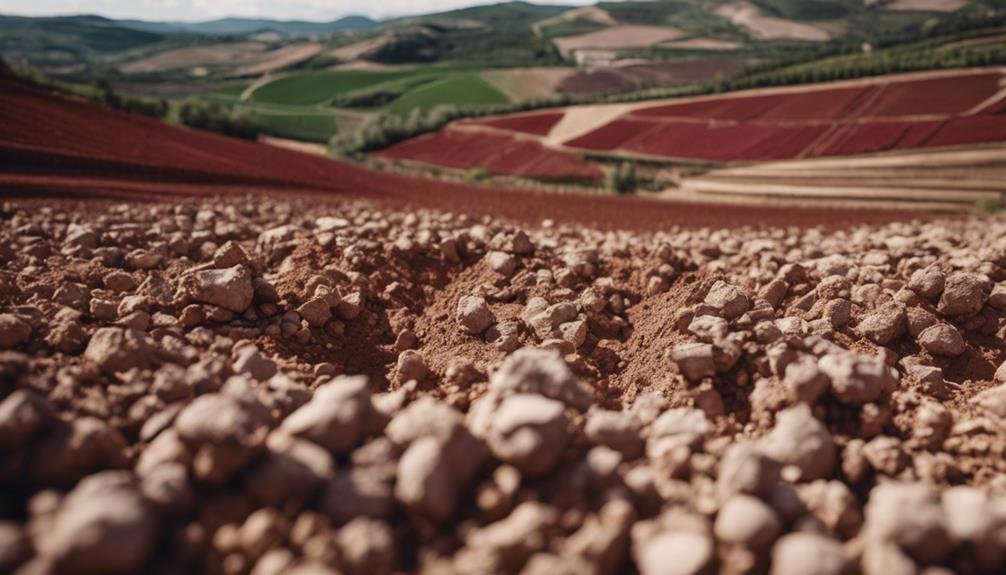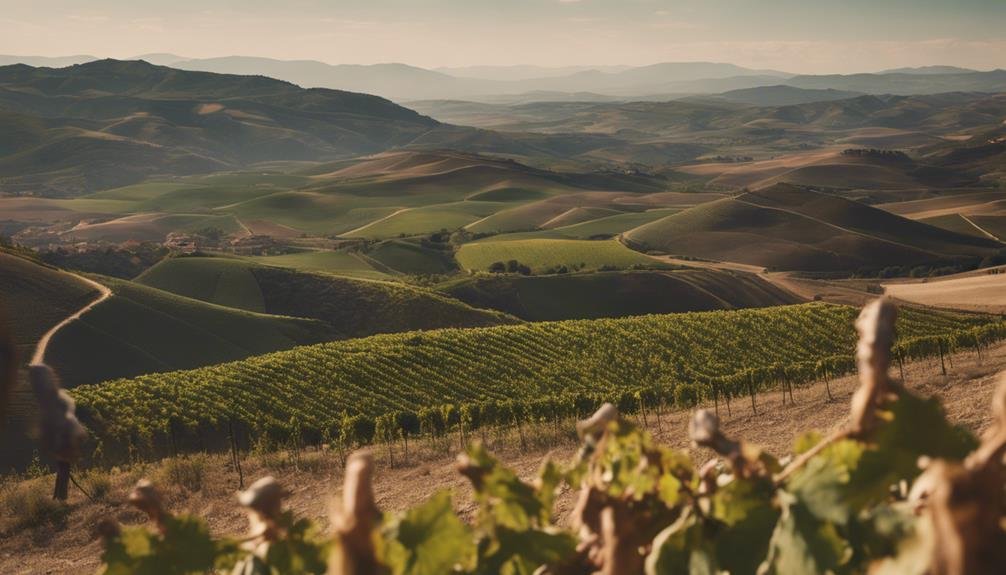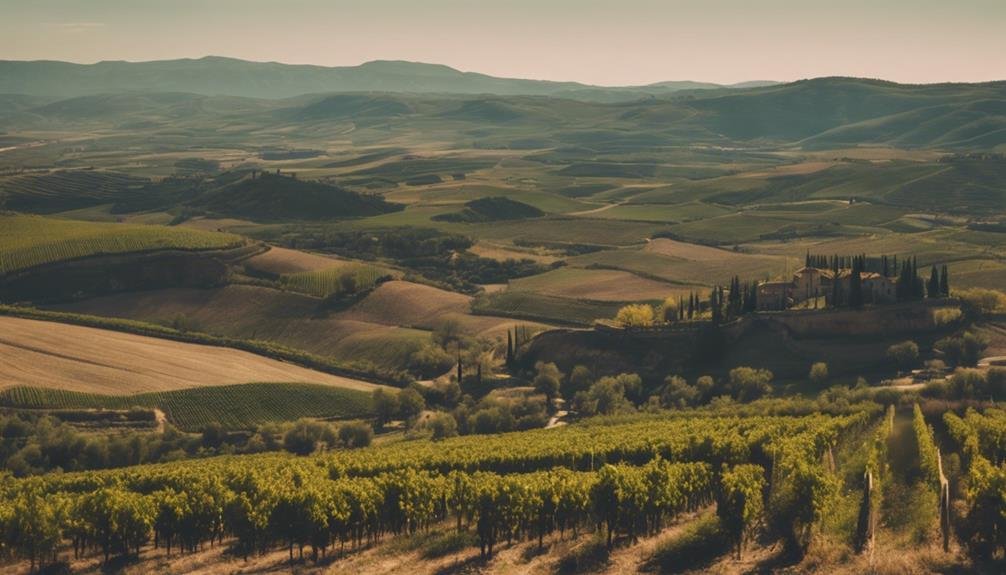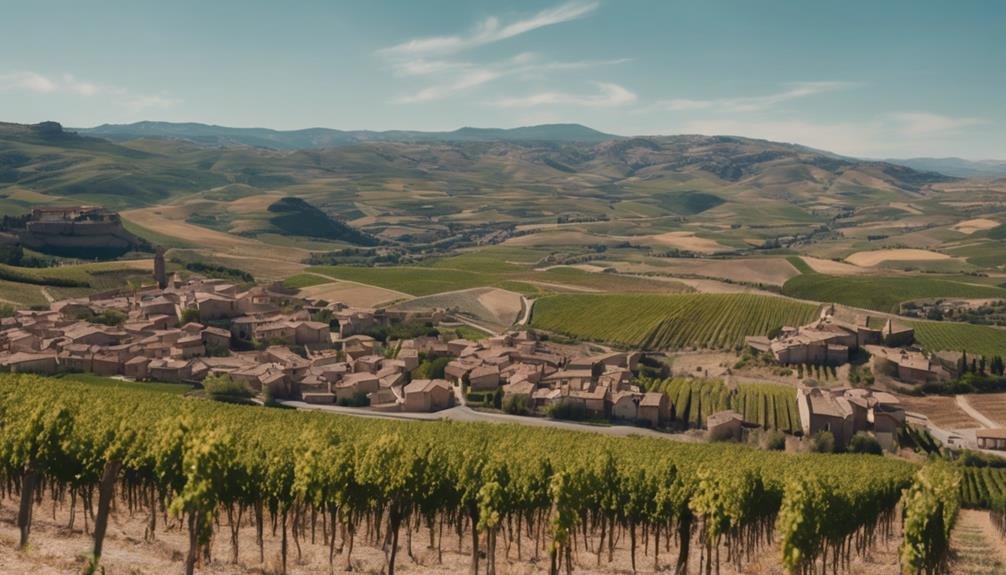Rioja's wine valleys boast unique terroirs that define their exceptional wines. The Oja Valley features clay and sandy soils, resulting in aromatic plump plum flavors. In Najerilla Valley, old vineyards on iron-clay soils yield rustic red fruit wines with depth. Iregua Valley's iron clay composition enhances medium acidity and fruity flavors. Leza Valley stands out with vibrant red fruit characteristics and enticing vanilla notes due to its unique terroir. Jubera Valley's varying elevations and limestone-rich soils influence notable wines like Tempranillo and Garnacha. The distinct flavors and styles in each valley showcase Rioja's diverse wine landscape.
Oja Valley Terroir
Nestled within the Rioja wine region, the Oja Valley boasts a distinctive terroir characterized by clay and sandy alluvial soils near its vineyards, producing wines with aromatic profiles and plump plum flavors.
The combination of clay and sand in the soil imparts unique characteristics to the grapes grown in this area, leading to wines with rich aromatic flavors that tantalize the senses. These wines are known for their delightful blend of aromas and flavors, with a particular emphasis on the luscious taste of plump plums.
The terroir of the Oja Valley plays a significant role in creating wines that stand out for their sensory appeal, making them a favorite among wine enthusiasts looking for distinctive and flavorful options.
Najerilla Valley Characteristics
The Najerilla Valley in the Rioja wine region is distinguished by its vast expanse of vineyard acres and the presence of old vineyards mainly featuring Tempranillo and Garnacha vines. These old vineyards contribute to the unique flavors found in wines from this valley.
The soils in Najerilla are mainly iron-clay, imparting smoky tobacco notes to the wines. This results in rustic red fruit flavors with heightened acidity and tannins, creating a distinctive profile. The combination of old vines and specific soil characteristics gives Najerilla Valley wines a unique charm that sets them apart from other regions in Rioja.
Winemakers in this area leverage these factors to produce wines with depth and complexity that showcase the terroir of Najerilla Valley.
Iregua Valley Soil Profile

In exploring the terroir of the Rioja wine region, the focus now shifts to understanding the distinctive soil profile of the Iregua Valley. The vineyards in this valley boast a soil composition rich in iron clay, contributing to the unique characteristics of the wines produced.
To enhance the quality of the wines, fruit selection techniques play a vital role in ensuring that only the finest grapes are used in winemaking. The medium acidity and fruity flavors found in wines from the Iregua Valley are a direct result of these soil properties and meticulous fruit selection methods.
- Iron clay composition enriches the soil
- Fruit selection techniques enhance wine quality
- Medium acidity and fruity flavors in wines
- Soil properties influence wine characteristics
Leza Valley Wine Styles
Located between the Rioja Alta and Rioja Baja regions, the Leza Valley showcases a distinctive array of young, fresh wines celebrated for their vibrant red fruit-driven characteristics. These wines from the Leza Valley are known for their fresh fruitiness and often feature enticing vanilla notes.
The valley's cooler climate in Rioja Alta contributes to the wines' lively acidity, while the iron clay soils provide a unique terroir that influences the flavor profile. Leza Valley wines are characterized by their youthfulness and brightness, appealing to those seeking vibrant and flavorful options.
The region's focus on producing red fruit-driven wines with a touch of vanilla complexity sets them apart, making them a delightful choice for wine enthusiasts looking for something unique.
Jubera Valley Terroir Influence

Nestled within the Rioja wine region, the Jubera Valley showcases a unique terroir that greatly influences the characteristics of its wines.
- Vineyard elevation, microclimate: The valley's varying elevations create diverse microclimates, impacting grape ripening and flavor development.
- Soil composition, grape varietals: Limestone-rich alluvial soils in the region nurture old vineyards, influencing the acidity and minerality of the wines produced.
- Grape varietals: Tempranillo and Garnacha vines thrive in these conditions, contributing to the distinctive flavors found in Jubera Valley wines.
- Wine villages: Notable villages like Murillo de Rio Leza and Ventas Blancas are key players in showcasing the unique terroir and flavors of wines originating from the Jubera Valley.
Rioja Sub-regions Impact
The delineation of Rioja into distinct sub-regions, namely Rioja Alta, Rioja Baja, and Rioja Alavesa, plays a significant role in shaping the diverse array of wine styles that emanate from this renowned Spanish wine region. Climate variations across these sub-regions influence grape varieties grown, impacting the flavor profiles of the wines produced.
Rioja Alta and Rioja Alavesa are known for wines with greater aging potential, while Rioja Baja also produces incredible wines depending on the producer's influence. The unique characteristics of each sub-region contribute to the overall richness and complexity of Rioja wines, showcasing the importance of terroir in winemaking.
Producers in each sub-region carefully navigate these factors to craft wines that reflect the distinct terroir and climate of their respective areas.
Cidacos and Alhama Valley Flavors

Embracing a distinct terroir and climatic conditions, the Cidacos and Alhama Valleys yield wines that captivate with bold flavors and unique characteristics.
The Cidacos Valley, known for its hot climate, produces wines with bold fruitiness and tobacco undertones. Organic vineyards thrive here due to limited pest stress.
On the other hand, the Alhama Valley, bordering Navarra and Campo de Borja, offers outstanding value wines with rich black raspberry flavors. UNESCO-recognized for its diverse flora and fauna, the best vineyards in Alhama are situated high in the mountains, contributing to the distinctiveness of the wines.
These valleys showcase the essence of Rioja through their bold and organic wine profiles.
Frequently Asked Questions
How Do the Unique Terroirs of Rioja Valleys Influence the Aging Potential of Wines?
Climate variations and grape varieties in Rioja valleys, such as Oja, Najerilla, and Iregua, create diverse microclimates impacting aging potential. Soil compositions and altitude contribute to distinctive flavors and structures, influencing the overall quality of wines.
What Traditional Winemaking Techniques Are Specific to Najerilla Valley Vineyards?
Traditional winemaking techniques specific to Najerilla Valley vineyards include hand-harvesting of old Tempranillo and Garnacha vines. Careful grape selection and manual processing enhance wine quality. These methods preserve the region's unique characteristics, resulting in distinctive Rioja wines.
How Do the Soil Profiles in Iregua Valley Contribute to the Diversity of Wine Flavors?
The soil profiles in Iregua Valley influence wine diversity through their composition. Iron-clay and alluvial sandy clay soils contribute to medium acidity and fruity flavors in wines. These soil characteristics play an essential role in flavor profile evolution.
What Modern Winemaking Practices Are Embraced in Leza Valley to Enhance Wine Quality?
In Leza Valley, winemakers embrace innovative techniques like temperature-controlled fermentation and extended maceration to enhance wine quality. Sustainable practices such as organic farming and minimal intervention winemaking are also key factors in producing exceptional wines.
How Do the Terroir Influences in Jubera Valley Impact the Complexity of Wines Produced?
Terroir influences in Jubera Valley profoundly impact wine complexity. Limestone-rich soils and high elevation produce hand-harvested old vineyards with distinct flavors. Wines from Jubera showcase exceptional complexity, reflecting the unique terroir of the region, elevating their quality and character.
Conclusion
To sum up, the diverse terroirs of Rioja's valleys create a vibrant tapestry of flavors and styles in its wines. From the Oja Valley's clay and sandy soils to the limestone-rich terroir of the Jubera Valley, each region contributes unique characteristics to the wines produced.
The Seven Valleys and Rioja sub-regions further enhance the complexity and diversity of Rioja wines. Exploring the interplay of terroir elements in Rioja is a fascinating journey for wine enthusiasts seeking distinctive and dynamic experiences.
